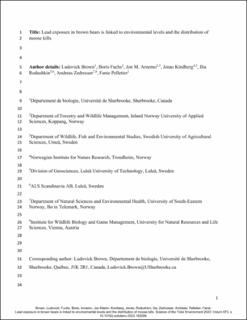| dc.contributor.author | Brown, Ludovick | |
| dc.contributor.author | Fuchs, Boris | |
| dc.contributor.author | Arnemo, Jon Martin | |
| dc.contributor.author | Kindberg, Jonas | |
| dc.contributor.author | Rodushkin, Ilia | |
| dc.contributor.author | Zedrosser, Andreas | |
| dc.contributor.author | Pelletier, Fanie | |
| dc.coverage.spatial | Sweden, Sverige | en_US |
| dc.date.accessioned | 2023-12-19T13:04:25Z | |
| dc.date.available | 2023-12-19T13:04:25Z | |
| dc.date.created | 2023-02-09T10:51:33Z | |
| dc.date.issued | 2023 | |
| dc.identifier.citation | Science of the Total Environment. 2023, 873 . | en_US |
| dc.identifier.issn | 0048-9697 | |
| dc.identifier.uri | https://hdl.handle.net/11250/3108212 | |
| dc.description.abstract | Lead (Pb) is heterogeneously distributed in the environment and multiple sources like Pb ammunition and fossil fuel combustion can increase the risk of exposure in wildlife. Brown bears (Ursus arctos) in Sweden have higher blood Pb levels compared to bears from other populations, but the sources and routes of exposure are unknown. The objective of this study was to quantify the contribution of two potential sources of Pb exposure in female brown bears (n = 34 individuals; n = 61 samples). We used multiple linear regressions to determine the contribution of both environmental Pb levels estimated from plant roots and moose (Alces alces) kills to blood Pb concentrations in female brown bears. We found positive relationships between blood Pb concentrations in bears and both the distribution of moose kills by hunters and environmental Pb levels around capture locations. Our results suggest that the consumption of slaughter remains discarded by moose hunters is a likely significant pathway of Pb exposure and this exposure is additive to environmental Pb exposure in female brown bears in Sweden. We suggest that spatially explicit models, incorporating habitat selection analyses of harvest data, may prove useful in predicting Pb exposure in scavengers. Ursus arctos Pb Scavenger Slaughter remain Resource selection function | en_US |
| dc.language.iso | eng | en_US |
| dc.rights | Navngivelse 4.0 Internasjonal | * |
| dc.rights.uri | http://creativecommons.org/licenses/by/4.0/deed.no | * |
| dc.subject | Ursus arctos | en_US |
| dc.subject | Pb | en_US |
| dc.subject | Scavenger | en_US |
| dc.subject | Slaughter remain | en_US |
| dc.subject | Resource selection function | en_US |
| dc.title | Lead exposure in brown bears is linked to environmental levels and the distribution of moose kills | en_US |
| dc.title.alternative | Lead exposure in brown bears is linked to environmental levels and the distribution of moose kills | en_US |
| dc.type | Peer reviewed | en_US |
| dc.type | Journal article | en_US |
| dc.description.version | acceptedVersion | en_US |
| dc.rights.holder | © 2023 The Authors | en_US |
| dc.subject.nsi | VDP::Zoologiske og botaniske fag: 480 | en_US |
| dc.subject.nsi | VDP::Zoology and botany: 480 | en_US |
| dc.source.pagenumber | 8 | en_US |
| dc.source.volume | 873 | en_US |
| dc.source.journal | Science of the Total Environment | en_US |
| dc.identifier.doi | 10.1016/j.scitotenv.2023.162099 | |
| dc.identifier.cristin | 2124437 | |
| dc.relation.project | Andre: Norwegian Environment Agency | en_US |
| dc.relation.project | Andre: Swedish Environmental Protection Agency | en_US |
| dc.relation.project | Norges forskningsråd: xxxxxx | en_US |
| dc.source.articlenumber | 162099 | en_US |
| cristin.ispublished | true | |
| cristin.fulltext | postprint | |
| cristin.qualitycode | 2 | |

